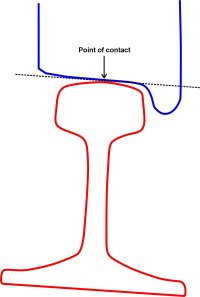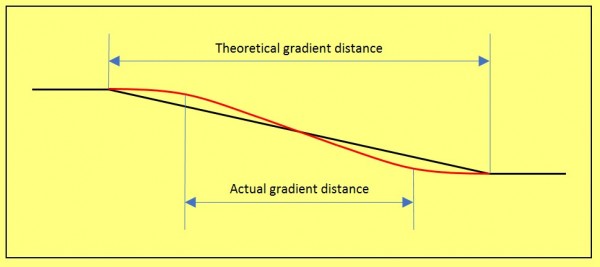TimberSurf’s Model Railway
Modelling Tips, Links & Guides for Model Railways

Lumsdonia Railway

A web page for my indulgence and sharing ideas and irregular updates on my Model railway






SALE
PLUS
How do you decide what angle of gradient to use on your layout
Incline/Decline angle Guide
Gradients
 Back to GUIDES
Back to GUIDES
Why is gradient so important?
A car’s tyre has a large surface area of contact with the tarmac, it is wide and because it is pneumatic, the bottom flattens out as it rolls to give a larger surface, it is made of rubber which has good adhesion to the rough tarmac.
In comparison, a train wheel to rail is metal to metal and the area of contact is very small. This means that the rolling friction is very small, allowing great weight to be supported and little effort required to get the load rolling, however this also means that the driving wheels have very little traction! On the flat, they work very well, but it does mean that excessive power applied will cause wheel slip. This has two effects, one that acceleration is limited by the trailing load and two that there is a reduction of traction as an incline increases. This is demonstrated when an engine is seen to wheel slip if too much power is applied starting from a station and the fact that a banking engine is required with heavy loads up a steep incline.
So what is normal?
There is no set maximum grade, different railways/countries/era’s had a wide range. Anything much more than 1% (1:100) would be be deemed as steep, there are some instances of as steep as 1:40 or slightly worse, but these are few. There are some exceptions like hump shunting and coal loading ramps and narrow guage is a whole other ball game! But most mainline are less than 1:100.
How does this translate to model railways?
Like the prototype, there is no fixed rule. Gradients simply scale and are much the same. If you have a 1% gradient, you will not have any problems. Unfortunately that means we need 33ft (10 meters) just to elevate a track above another line!
To cross a railway, you need the height of underlay, track, tallest rolling stock plus thickness of bridge/tunnel above it, ranges from about 3-4 inches.
Hornby will make you believe you can make an overbridge in 180° on 2nd radii! I doubt you would get an engine and two carriages to make at full tilt, even with a run up!
There are lots of figures out there ranging from 1:30 to 1:40, but even these are debatable. Even 1:60 will cause wheel slip if the train is long (8 carriages). One solution is to use 'DCC Concepts Powerbase', but that means fitting magnets to every loco.
I scrapped my first layout because I got it wrong! (4in in 72in = 1:18), so I would recommend at least 1:36 or better! My current design will be 1:72 (I will run very long trains with strong Loco's!)
P.S. having a curve on the incline will adversely effect (reduce) the pulling power too!
You also need to allow extra length at top and bottom for the transition from gradient to flat.

What will work will also depend on the effective traction of your loco! The more driven wheels the better and the more weight the better. Older loco’s (not all wheel drive and lighter) will be outperformed by modern purchases. Setting up a temporary inclined track and testing YOUR Loco's is the only sure way to determine what you can get away with.
Inclines can be problematical, if you just want bridges and tunnels, consider setting the rails 4 inches above the base sitting on contoured raised hills and embankments and just have scenics and roads at the lower level and go under it.
What is a gradient?
When trains go up (incline) or down (decline) a hill, the angle is referred to as the gradient, sometimes shortened to the word Grade, commonly understood as a slope.
Although in maths it would be called the angle from horizontal, engineers for roads and rail express it as a ratio or percentage. The ratio is the amount the gradient increases in relation to the distance along the horizontal, expresses as 1:100 as an example. Similarly it could also be expressed as a 1% slope or grade.
So as a further example, if a slope were 1 in 5, it could be expressed as 20:100 but would normally be reduced to 1:5 or 20% as a percentage.
In conclusion (in general and not a rule)
For short trains (2-4 carriages) minimum of 1:40
For long trains (5-8 carriages) minimum of 1:60
Avoid curves on an incline (else allow better gradient)
Allow 12in (30cm) extra length at top and bottom for the transition from gradient to flat
Longer trains can be pulled if DCC concepts Powerbase (or similar) is fitted
Adding weight to you’re loco’s will increase tractive effort